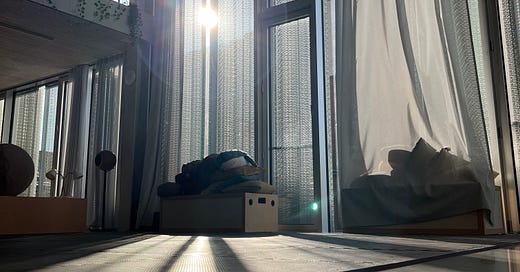new little bablyons
on my Medley Residency and the little temporary cities within, by Maria Saridaki
“Everyone will, so to speak, live in their own personal “cathedrals.” There will be rooms more conducive to dreams than any drug, and houses where one cannot help but love.” Ivan Chtcheglov - Formulary for a New Urbanism1
I walk a lot. Getting lost in cities and allowing the city to inform and change me, is what I do. Even during the pandemic I would walk and walk and walk, as much as I was allowed, and then a wee bit more.
So, I was surprised when during my days and nights as a Medley Resident, I did not need to walk and wander and drift in the city. The weather was fantastic, Berlin was inviting and the other residents were requesting walks from me. But I stayed indoors and chose to observe, them and me, in the space of Medley. Amongst unannounced temporary situations of becoming. Amongst the angry and the soft, the restless and the cool. Discussions and dances, workshops and silent work, heated monologues, and calm sharings. For almost three months, I would spend my days and nights, with each temporary group, focus, attraction, and encounter. It seemed that my thirst for wandering, my need for rapid passages through varied ambiances outside, was quenched in Medley. It seemed that I was drifting and doing my wandering and dérive indoors, from an interesting interaction to a unique-for-me pool of knowledge. My mind and body were exactly where they needed to be. In this new temporary city.
Medley was different than a residency, unusual as a workspace, abnormal as a permanent structure. Its utility was in question and its results were already visible to us all. One quiet afternoon as I was observing, from the upper-level, different interactions and ways of working between the residents, the concept of New Babylon, the lucid utopian city of the ludic creatives, popped up in my mind. The building, higher but not too high above the utilitarian world outside, visible and discreet at the same time, stood as a contradiction for all of us to fill with creativity and enjoyment. What a privilege and what a paradigm shift!
For twenty years, the dutch artist Constant Nieuwenhuys, known simply as ‘Constant’, held persistently to a revolutionary play-centered vision of a new world, a new way of being. From the mid-1950s to the mid-1970s, he used art and architecture to build his dream world, he used collage and modeling, lithographs and maps, describing and manifesting his ludic city, one he called New Babylon.
“The modern city is dead; it has been sacrificed to the cult of utility. New Babylon is the project for a city in which people will be able to live. For to live means to be creative2”
It was characterized as yet another failed utopia, as Constantin’s romantic optimism based all prerequisites of such a bliss to automatization, failing to see practical problems and applications, before his work was dismissed as theoretical, by his critics. An impossibility —and yet here I was, in a modern cathedral in Berlin Mitte, in the middle of one at the moment of its creation. Space itself was our psychic dimension. The light would play with the shadow between Medley’s concrete and glass, transforming the space and giving us new ways to see. Safely and gently we were swinging above the ground. Close enough to understand and give back to the city. High enough to lose ourselves in our efforts for collective ownership in this dynamic labyrinth. Impermanence in concrete.
In New Babylon, “by liberating people from the imperative of work, the society of the future would produce a ‘homo ludens’ (‘man at play’), free to exercise personal creativity and to travel at will. Above the existing cities, new environments would be created where everyone would be free to move around as they wished3”. What an abundance of flavors, what a membrane, what a privilege. And I was there for a moment. Amidst my personal change and daily guilt for this privilege, during my own new path making and heartbreaking. For a moment.
During events and quiet evenings in our communal/personal Medley cathedral, little impermanent neighborhoods would form, according to the change of the topography, different scaffolds of bodies and plays of energy, or the way the light would reflect, as we were reflecting back our ideas, our lights, and shadows.
I was drifting between the little puddles of interaction, the brainstorming circles, the one-on-one to share-and-bare. Who we are, from where we came and where we could go. Our wee new babylons, allowed by automatization, nomadism, and the possibility to use capitalism, for a moment, for a blink of an eye, on our behalf, extended by a common need to be better. Quiet evolutions, in higher grounds, between concrete and glass, between public space and effortless intimacy.
“New Babylon is the work of the New Babylonians alone, the product of their culture. For us, it is only a model of reflection and play4", Constant wrote in 1974. In Medley more or less effortlessly but not without resistance, this is what felt like a main project to most of us. In the Medley togetherness, our personal projects became a second layer that was sculpting the first, between needs, resistances and desires. The Medley way to be with others. Experimental collective creativity that could lead to dance eruptions, or the next career path, or to an open day, or maybe to a brand new work process or a unique philosophical path. A giving, tender dojo of re-learning how to be with oneself and with others. Creative, collective, calm, corporate, carefree, counterproductive, anything could be. Any way one would choose, or had to offer at the given moment. The new way to be, the new way to labor in constant creativity and with a playful, yet societal and planetary conscious spirit. The fluffy carpet riders, the embodied floor rollers, the ideas wanderers, the noble tech wizards, the sensible artists, the desire architectures. The new rooms within us, that we might visit, revisit, dream and avoid. New little babylons.
Another failed utopia they said, well I was there and the gardens were hanging and the fruits were sweet. As for the seeds and what will be until they bloom again…
I guess I need to start walking.
Büsch, T. (2018) Find your cathedral – blow up the Eiffel Tower, InEnArt. (Accessed: March 9, 2023).
Constant Nieuwenhuys and Simon Vinkenoog, New Babylon: Ten Lithographs, Amsterdam: Galerie d’Eendt, 1963: p. 10.
Kunstmuseum Den Haag (2018) Constant – new babylon, Kunstmuseum Den Haag. (Accessed: March 9, 2023).
Constant (1974) New Babylon. For the exhibition catalogue published by the Haags Gemeetenmuseum, The Hague, 1974.






